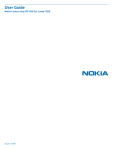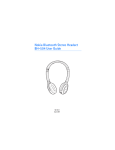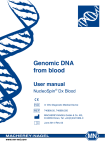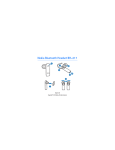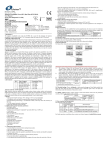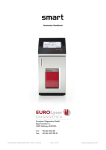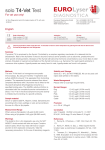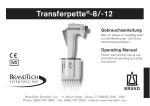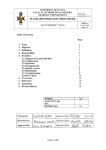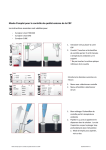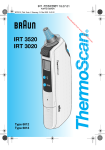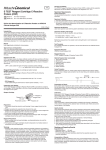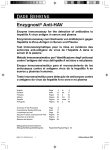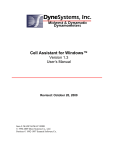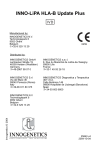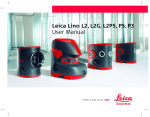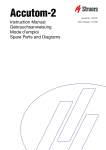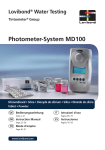Download SAA-VET test kit
Transcript
SAA-VET test kit For veterinary use only! Veterinary test kit for quantitative in vitro determination of SAA with solo analyser. Eurolyser Diagnostica GmbH Tel. +43 (0)662 / 43 21 00 Fax +43 (0)662 / 43 21 00-50 www.eurolyser.com 11 a M Bayernstraße 5020 Salzburg/Austria English i Y Order Information Order number: VT 01 70 Order number: VT 1 700 Indication SAA-VET test kit SAA-VET control kit Kit size 6 tests/pack 1 x 2 ml (decision level) Test kit preparation: Allow single test min. 1 0 minutes to warm up to room temperature by placing the test into the test kit rack. Put test kit package back into refrigerator. Summary Serum Amyloid A (SAA) is an early and sensitive blood biomarker for tissue injury and inflammation and has been indicated in many inflammatory diseases. The level of SAA circulating in the blood is known to increase dramatically in response to tissue damage or inflammation, classifying it as an acute phase protein. Circulating SAA concentrations may increase up to 1 000-fold following inflammation, infection, tissue injury and cell necrosis and decline rapidly following recovery. It has also been observed in several veterinary species including the horse that SAA is a very useful inflammatory marker that may be used for detection of clinical and possibly subclinical disease, monitoring of disease activity and response to therapy, prognostication, and detection of spread of infections in herds (Nielsen et al., 2004). The kinetic profile of the SAA response makes SAA an excellent indicator of inflammation. Hepatic SAA synthesis begins shortly after an inflammatory insult. As a result plasma concentrations start to increase within few hours, and they peak 36–48 h after injury, as demonstrated previously in horses after experimental induction of inflammatory or infectious disease (Hulte´n et al., 2002). Method / Measurement Range Latex agglutination test based on optical measurement of the change in turbidity caused by the agglutination of the latex particles sensitised with SAA antibodies. Measurement ranges: Horse: 1 0 - 500 µg/ml (1 0 - 500 mg/l) Cat: 1 0 - 1 50 µg/ml (1 0 - 1 50 mg/l) Samples with concentrations higher than the upper limit of the measurement range must be diluted 1 to 2 with physiological saline (0,9% NaCl), eg. 20 µl sample + 40 µl 0,9%-NaCl-solution, and the result then multiplied by 3. Lower detection limit: 1 0 µg/ml Stability and Storage Store at 2 - 8°C. DO NOT FREEZE. Kit can be used until expiry date printed on the labels. Sample Material Use serum for routine analysis only. In several cases milk and synovial fluids can be used for SAA detection as well. Warnings and Precautions This testkit is for veterinary in vitro diagnostic use only! DO NOT INGEST. Avoid contact with skin and eyes. Contains sodium azide, which may react with lead or copper plumbin to form explosive compounds. Take the necessary precautions for the use of laboratory reagents. Quality Control Good laboratory practice suggests the use of control specimens to ensure proper assay performance. Controls results must fall within the established ranges, as determined by your laboratory. If results fall outside of the established ranges, assay results are invalid. Reference Ranges Cat: < 1 0 µg/ml Horse: < 20 µg/ml Camel: < 1 0 µg/ml For further species please establish laboratory internal normal ranges. These ranges are given for orientation only. Each laboratory should establish its own reference values. Precision for Plasma cv (99 µg/ml) < 8 % n=20 Correlation y = 0,98x + 0,1 2 y = "solo", x = (Eiken Chemicals SAA on Eurolyser CCA1 80) Reference Methode Waste Management Please refer to local legal requirements. Literature Hansen A.E., Schaap M.K., and Kjelgaard-Hansen M. Evaluation of a commercially available human serum amyloid A (SAA) assay for determination of feline SAA concentration. Vet. Res, Comm. 2005 August; 29 (Suppl.2) : 1 -1 0 SAA-VET test kit Nur für veterinären Gebrauch! Veterinär-Testkit für die quantitative In-Vitro-Bestimmung von SAA am solo Analyser. Eurolyser Diagnostica GmbH Tel. +43 (0)662 / 43 21 00 Fax +43 (0)662 / 43 21 00-50 www.eurolyser.com 11 a M Bayernstraße 5020 Salzburg/Austria Deutsch i Y Bestellinformation Bestellnummer: VT 01 70 Bestellnummer: VT 1 700 Bezeichnung SAA-VET test kit SAA-VET control kit Packungsgröße 6 Tests/Packung 1 x 2 ml (decision level) Vorbereitung des Testkits: Der Einzeltest muss mindestens 1 0 Minuten auf Raumtemperatur aufgewärmt werden. Geben Sie dazu den Test aus der Packung und setzen Sie ihn in das Testkit-Rack. Geben Sie die Testpackung zurück in den Kühlschrank. Zusammenfassung Serum Amyloid A (SAA) ist ein früh erkennbarer und sensibler Blut-Biomarker bei Gewebeschäden und Entzündungskrankheiten. Es ist bekannt, dass die Konzentration der SAA-Zirkulation im Blut bei auftretenden Gewebeschäden und Entzündungskrankheiten dramatisch ansteigt und wird daher als Akut-Phase-Protein klassifiziert. Nach einer Entzündung, Infektion, Gewebeschäden oder Zellnekrose kann die Konzentration der SAA-Zirkulation bis zu 1 000-fach ansteigen, fällt jedoch auch sehr schnell bei Heilung wieder ab. Des Weiteren wurde bei einigen veterinären Spezies wie z.B. dem Pferd beobachtet, dass SAA ein sehr hilfreicher Entzündungsmarker zur Erkennung klinischer und möglicher subklinischer Erkrankungen, Beobachtung von Krankheitsaktivitäten, Prognosen und der Erkennung einer Infektionsausbreitung in Herden ist (Nielsen et al., 2004). Das kinetische Profil einer SAA-Reaktion macht SAA zu einem exzellenten Entzündungsindikator. Hepatische SAA-Synthese beginnt kurz nach einer Entzündung. Nach experimenteller Induktion von Entzündungen oder infektiösen Krankheiten wurde festgestellt, dass daraufhin die Plasmakonzentration binnen weniger Stunden steigt und ihren Höhepunkt 36-48 Stunden nach der Verletzung erreicht (Hulte’n et al.,2002). Methode / Messbereich Latex-Agglutination-Test basierend auf einer optischen Messung der Veränderung der Trübung, verursacht durch die Agglutination der Latex-Partikel sensibilisiert mit SAA Antikörper. Messbereich Pferd: 1 0 - 500 µg/ml (1 0 - 500 mg/l) Messbereich Katze: 1 0 - 1 50 µg/ml (1 0 - 1 50 mg/l) Proben mit höheren Konzentrationen als das obere Limit des Messbereichs müssen 1 zu 2 mit physiologischer Kochsalzlösung (0,9% NaCl) verdünnt, z.B. 20 µl Probe + 40 µl 0,9%-NaCl-Lösung, und das Ergebnis anschließend mit 3 multipliziert werden. Unteres Detektionslimit: 1 0 µg/ml Lagerung und Haltbarkeit des Testkit Bei 2 - 8°C gelagert, bis zum aufgedrucktem Haltbarkeitsdatum verwendbar. NICHT EINFRIEREN. Probenmaterial Verwenden Sie in der Routine ausschließlich Serum für den Testvorgang. In einigen Fällen kann auch Milch und Gelenksflüssigkeit zur SAA Erkennung verwendet werden. Warnungen und Vorsichtsmaßnahmen Der Test ist ausschließlich für den veterinären In-VitroDiagnostik Einsatz ausgelegt! Nicht verschlucken! Berührung mit Haut und Augen vermeiden. Enthält Natriumazid das mit Blei und Kupfer reagieren und explosives Gemisch bilden kann. Beachten Sie die notwendigen Vorsichtsmassnahmen für den Gebrauch von Laborreagenzien. Qualitätskontrolle Um die ordnungsgemäße Leistung der Messung gewährleisten zu können wird die Verwendung einer KontrollProbe empfohlen. Die Kontrollergebnisse müssen innerhalb des festgelegten Bereichs liegen, welcher von Ihrem Labor ermittelt wurde. Wenn die Messergebnisse außerhalb des festgelegten Bereichs liegen, ist die Prüfung als ungültig zu betrachten. Normalbereich Katze: < 1 0 µg/ml Pferd: < 20 µg/ml Kamel: < 1 0 µg/ml Für weitere Spezies evaluieren sie laborinterne Normalbereiche. Diese Normalbereiche dienen ausschließlich zur Orientierung. Jedes Labor sollte eigene Referenzwerte evaluieren. Präzision für Serum cv (99 µg/ml) < 8 % n=20 Korrelation y = 0,98x + 0,1 2 y = "solo", x = (Eiken Chemicals SAA mit Eurolyser CCA1 80) Referenz Methode Entsorgung Bitte beachten Sie die jeweiligen gesetzlichen Vorschriften. Literatur Hansen A.E., Schaap M.K., and Kjelgaard-Hansen M. Evaluation of a commercially available human serum amyloid A (SAA) assay for determination of feline SAA concentration. Vet. Res, Comm. 2005 August; 29 (Suppl.2) : 1 -1 0 Durchführung SAA-VET Test Processing of SAA-VET test 1. 1 .1 1 .2 1 .3 1 .4 2. 2.1 3. 3.1 a ODER/OR 3.1 b 3.2 3.3 3.4 Deutsch English ACHTUNG! ATTENTION! 1. Testsystem vorbereiten 1. Preparation of test system 2. Für weitere Details beachten Sie bitte das Anwenderhandbuch des Laborphotometers 2. Start der Analyse durch Drücken des Start Buttons. 2.1 For further details please see user manual of laboratory photometer Probenvorbereitung Serum oder Plasma 3. Tests 1 0 Minuten vor Gebrauch bei Raumtemperatur aufwärmen lassen! 1 .1 1 .2 1 .3 1 .4 2.1 3. RFID-Karte einsetzen ERS Küvette in Probenhalter geben ERS Kappe in Probenhalter geben Mess-Taste drücken, die erforderlichen Daten über das Touch-Display eingeben 3.1 a 5 µl Serum aus Primärgefäß pipettieren ODER ... 3.1 b 5 µl Plasma aus zentrifugiertem KapillarProbenentnahmegefäss pipettieren 3.2 5 µl Probe in ERS Küvette IN FLÜSSIGKEIT pipettieren 3.3 ERS Kappe fest auf ERS Küvette aufsetzen 3.4 ERS Cartridge in Laborphotometer einsetzen 3.5 Automatische Testabarbeitung durch drücken des Start Buttons. Allow test min. 1 0 minutes to warm up to room temperature! 1 .1 1 .2 1 .3 1 .4 Insert RFID card Place ERS cuvette in test kit rack Place ERS cap in test kit rack Press measurement button, enter required information using the touch screen Start of analysis by pressing the start button. Sample preparation serum or plasma 3.1 a Pipette 5 µl serum from primary tube OR ... 3.1 b Pipette 5 µl plasma from centrifuged sample tube 3.2 Pipette 5 µl sample into ERS cuvette INTO LIQUID 3.3 Firmly apply ERS cap on ERS cuvette 3.4 Place ERS cartridge into laboratory photometer 3.5 Start automatic sample processing by pressing the start button. Technical details subject to change without notice. Doc-ID: e586c9cf-9282-433d-ac1 c-1 a802306b6a4 ; latest revision: DP1 .0 ; date of print: 201 4-1 2-05




